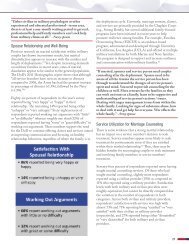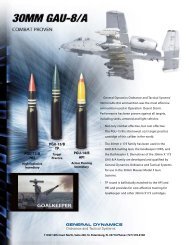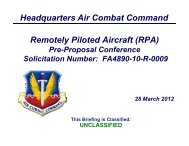F-35 Joint Strike Fighter (JSF) - WordPress.com
F-35 Joint Strike Fighter (JSF) - WordPress.com
F-35 Joint Strike Fighter (JSF) - WordPress.com
Create successful ePaper yourself
Turn your PDF publications into a flip-book with our unique Google optimized e-Paper software.
DOD PROGRAMS<br />
validation data needed to accredit the GPS System Model<br />
Simulation (GSMS) and Modeling System for Advanced<br />
Investigation of Countermeasures (MOSAIC) infrared<br />
countermeasures effectiveness models.<br />
• In 2011, the Air Force airworthiness authorities identified the<br />
pilot escape system installed in the early LRIP aircraft as a<br />
serious risk. Validation of expected performance of the F-<strong>35</strong><br />
escape system is supported by modeling the ejection seat as<br />
well as the effectiveness of the transparency removal system<br />
for the canopy during the ejection sequence.<br />
--<br />
For the ejection seat model, the program used data<br />
from sled testing under straight and level conditions to<br />
predict performance of the ejection seat under non-zero<br />
angle‐of‐bank (including inverted) conditions. Interactions<br />
between the pilot, the ejection seat, and the canopy during<br />
the ejection sequence, however, are not well understood,<br />
particularly during other than straight and level ejection<br />
conditions.<br />
--<br />
Testing of the transparency removal system under<br />
off‐nominal conditions to better understand these<br />
interactions was scheduled for March 2012. The program<br />
expects this testing to take place in December 2012.<br />
Training System<br />
• The program initiated flight operations at the Integrated<br />
Training Center, Eglin AFB, Florida, in 2012 with both the<br />
F-<strong>35</strong>A and F-<strong>35</strong>B aircraft.<br />
- The Air Force accepted six F-<strong>35</strong>A aircraft from production<br />
Lot 2 in 2011 at Eglin in the Block 1A configuration, but<br />
did not <strong>com</strong>mence flight operations until March 2012<br />
when the Air Force airworthiness authorities provided<br />
the necessary flight clearance, which limited operations<br />
to previously qualified F-<strong>35</strong> pilots. In July, the Air Force<br />
changed the flight clearance to allow pilots not previously<br />
qualified to fly at Eglin, which paved the way for F-<strong>35</strong>A<br />
pilot training to begin later in the year.<br />
- The program delivered six F-<strong>35</strong>B aircraft from production<br />
Lot 2 to Eglin between January and May 2012. Also in<br />
May, Navy airworthiness authorities provided a flight<br />
clearance for F-<strong>35</strong>B flight operations to begin at Eglin.<br />
- The program added 10 production Lot 3 aircraft – all<br />
in the Block 1B configuration – to Eglin by the end of<br />
October 2012 to support flight training: 3 F-<strong>35</strong>A aircraft<br />
between July and August and 7 F-<strong>35</strong>B aircraft (5 for the<br />
Marine Corps and 2 for the United Kingdom) between July<br />
and October. These deliveries were later than planned due<br />
to late availability of an adequate Autonomous Logistics<br />
Information System (ALIS) at Eglin to support the<br />
Block 1B aircraft configuration.<br />
• In July 2012, DOT&E re<strong>com</strong>mended to the Air Force, the<br />
operational test agencies, and the <strong>JSF</strong> Program Office that<br />
the training OUE be delayed until the system matures and<br />
possesses some <strong>com</strong>bat capability relevant to an operational<br />
evaluation.<br />
- DOT&E identified seven indicators which highlighted a<br />
lack of overall system maturity: abort rates higher, and<br />
38 F-<strong>35</strong> <strong>JSF</strong><br />
trending flat, than the Air Force risk assessment identified<br />
for a maturing system; the trend in discovery as indicated<br />
by the rate of new Deficiency Reports; the high number<br />
of “workarounds” needed to support maintenance and<br />
sortie generation activities (including engineering support<br />
from the contractor); lack of a water-activated parachute<br />
release system (qualification testing is delayed until<br />
2013); in<strong>com</strong>plete testing of the escape/ejection system;<br />
low overall availability rates; and no new information or<br />
plans to address deficiencies in the Integrated Caution and<br />
Warning System.<br />
- The Air Force elected to begin the training OUE in early<br />
September 2012, and concluded it in mid-November 2012.<br />
The system under test had no <strong>com</strong>bat capability. Flight<br />
training events were limited to basic aircraft maneuvers<br />
called for in the “familiarization” pilot transition syllabus,<br />
which is a six-flight module of training. Pilots were trained<br />
in basic ground procedures, take-off, approach / landing,<br />
and formation flight. Radar, electronic warfare,<br />
countermeasures, and weapons capabilities were not<br />
included in the syllabus as they were either restricted from<br />
being used or were not available. Flight maneuvering was<br />
restricted to 5.5 g’s, 550 knots, 18 degrees angle-of-attack,<br />
and below 39,000 feet altitude, and was further constrained<br />
by numerous aircraft operating limitations that are not<br />
suitable for <strong>com</strong>bat. The maintenance environment and<br />
support systems are still immature. Sortie generation was<br />
dependent on contractor support personnel, maintenance<br />
personnel had to use workarounds to ac<strong>com</strong>modate<br />
shortfalls in ALIS, and the <strong>Joint</strong> Technical Data was<br />
in<strong>com</strong>plete. DOT&E will provide an independent report<br />
on the evaluation in early 2013.<br />
• As of the end of OUE in November, 276 sorties and 366 hours<br />
had been flown in the F-<strong>35</strong>A aircraft at Eglin, with the first<br />
flights in March, and 316 flights and 410 hours flown in the<br />
F-<strong>35</strong>B, since starting in May.<br />
- Aircraft availability rates for the F-<strong>35</strong>A varied from less<br />
than 5 percent to close to 60 percent in a given week from<br />
the first flights in March through October, with an average<br />
availability of less than <strong>35</strong> percent, meaning three of nine<br />
aircraft were available on average at any given time. For<br />
the F-<strong>35</strong>B, availability rates varied monthly as well from<br />
less than 5 percent to close to 50 percent, with similar<br />
average rates over the six months of flying.<br />
- Cumulative air abort rates over the same time period were<br />
also similar between the two variants with approximately<br />
five aborts per 100 flight hours observed (4.7 for the F-<strong>35</strong>A<br />
and 5.3 for the F-<strong>35</strong>B). In 2010, the Air Force used air<br />
abort rate as an objective metric for assessing the maturity<br />
needed to start flight training, with a goal of 1.0 air abort<br />
per 100 flight hours as a threshold to start an evaluation of<br />
the system’s readiness for training. Ground abort rate was<br />
one ground abort in seven scheduled sorties (0.14) for the<br />
F-<strong>35</strong>A and one in eight (0.13) for the F-<strong>35</strong>B.<br />
• The center conducted maintenance training for experienced<br />
maintenance personnel for both the F-<strong>35</strong>A and F-<strong>35</strong>B






